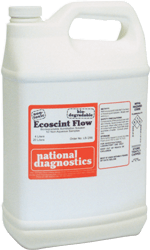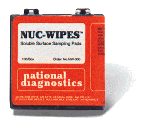Liquid Scintillation
Ecoscint Ultra
$233.00
Catalog Number: LS-270
Size: 4 liter
- The Best Performing Cocktail on the Market
- Readily Biodegradable
- Ideal Cocktail for Environmental Testing
- Ultra-High Sample Hold
- Low Toxicity
Description
Catalog Number: LS-270
Size: 4 liter
- The Best Performing Cocktail on the Market
- Readily Biodegradable
- Ideal Cocktail for Environmental Testing
- Ultra-High Sample Hold
- Low Toxicity
When National Diagnostics laboratories set out to create Ecoscint Ultra, our aim was to create the best cocktail available for environmental sample counting and urine bioassay. We are proud to announce that not only have we succeeded in this goal, we have surpassed it, creating the best all-around performing cocktail on the market for both large and small aqueous samples.
Ecoscint Ultra enables ultra-low level counts to be discriminated from background not only for large but also for small samples. With large samples, Ecoscint Ultra delivers up to 30% 3H counting efficiency at maximum sample hold with very low background levels. With small samples, Ecoscint Ultra yields 3H efficiency greater than 60%.
10ml of Ecoscint Ultra holds 12ml H2O or 10ml 0.5M NaCl in a clear emulsion at 18°C.
Additional information
| Weight | 10 lbs |
|---|---|
| Dimensions | 15 × 10 × 13 in |
Safety Overview
Safety Summary (see SDS for complete information before using product):
Appearance and Odor:
Nearly odorless, clear, blue-violet fluorescent liquid.
EMERGENCY OVERVIEW – IMMEDIATE HAZARD
Bis(1-methylethyl) naphthalene
May cause eye and skin irritation. May cause respiratory and digestive tract irritation. The toxicological properties of this material have not been fully investigated.
Butyl Dioxitol
Hazardous in case of eye contact (irritant), of ingestion, of inhalation. Slightly hazardous in case of skin contact(irritant, permeator).
Linear alkyl phenyl ethoxylates
CAUSES EYE IRRITATION. MAY CAUSE RESPIRATORY TRACT IRRITATION.
- Waste Disposal Issues in Scintillation Counting
- The Complete Scintillation Cocktail
- Radioactive Emissions and the Use of Isotopes in Research
- Preparing Tissue Samples for Scintillation Counting
- Preparing Samples in PAGE Gels for LSC
- Mechanism of Liquid Scintillation Counting
- Measurement of Radiation and Isotope Quantitation
- Liquid Scintillation Signal Interpretation
- Liquid Scintillation and Radiation Safety
- HPLC Flow Counting
- Counting Samples on Cellulose-Ester Filters
- Counting Samples from TLC Plates by LSC
- Counting Efficiency and Quenching
- Counting Carbon Dioxide by LSC
- Chemiluminescence and Static Electricity
- Assaying Discrete Samples by Liquid Scintillation Counting





